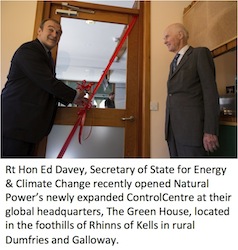 Central MN Ethanol Co-op (CMEC) has signed a letter of intent to sell substantially all of its assets to Green Biologics. Based In Little Falls, Minnesota, CMEC is an ethanol production facility that produces 21 million gallons of ethanol per year. Ocean Park Advisors acted as the exclusive financial advisor to CMEC in connection with the sales process. The firm acted as financial advisor to CMEC on the sale of its minority stakes in Guardian Energy, KAAPA Ethanol and Bushmills ethanol earlier this year. Financial terms of the transaction were not disclosed and timing of the transaction closing is expected in 2014.
Central MN Ethanol Co-op (CMEC) has signed a letter of intent to sell substantially all of its assets to Green Biologics. Based In Little Falls, Minnesota, CMEC is an ethanol production facility that produces 21 million gallons of ethanol per year. Ocean Park Advisors acted as the exclusive financial advisor to CMEC in connection with the sales process. The firm acted as financial advisor to CMEC on the sale of its minority stakes in Guardian Energy, KAAPA Ethanol and Bushmills ethanol earlier this year. Financial terms of the transaction were not disclosed and timing of the transaction closing is expected in 2014.- Greenbelt Resources Corporation, a provider of sustainable energy production systems, has announced the appointment of Joseph Pivinski to the executive team as interim chief financial officer. One of Joe’s first tasks is to update the company’s financial statements reported via OTC Markets. Pivinski served previously as CFO and senior vice president at NASDAQ-listed Consolidated Water Co., Ltd., and as vice president of finance and CFO for Oriole Homes Corp., a then-NASDAQ publicly traded residential real estate developer based in Florida.
- Green Plains Renewable Energy, Inc. has announced the pricing of its offering of $100 million aggregate principal amount of Convertible Senior Notes due 2018, which was upsized from the previously announced $75 million aggregate principal amount of notes. The notes will be offered and sold to qualified institutional buyers pursuant to Rule 144A under the Securities Act of 1933, as amended, by the initial purchasers of the notes. The Company has also granted the initial purchasers of the notes a 30-day option to purchase up to an additional $20 million aggregate principal amount of notes, solely to cover over-allotments.
- Suntech Power Holdings has announced a change in senior management, with David King stepping down as CEO and acting CFO and Zhou Weiping assuming the roles of interim CEO and interim CFO with immediate effect. The board of the Company will commence a search for a new CFO. Zhou will retain his roles as President and Director of the Company.
Growth Energy Pleased with New Holland Support
“New Holland is a fantastic company, they produce top notch equipment, but they also are willing to step up for rural America,” said Growth Energy CEO Tom Buis. “What we’ve seen over the last few years is New Holland take the lead in promoting biofuels.”
Buis says Growth Energy members participate with New Holland on promotional deals – in fact, one will be held next week at the Absolute Energy plant in Lyle, Minnesota. Interview with Tom Buis, Growth Energy
Growth Energy co-chairman retired U.S. Army General Wesley Clark praised New Holland’s support for national security. “New Holland is the first, most visionary and innovative company (that) saw what this ethanol movement means for America, for national security and for American prosperity,” said Clark, who adds that company vice president Abe Hughes, who serves on the Growth Energy board, has been a real leader in helping reach out to the American farmer.Interview with Wesley Clark, Growth Energy
Gas Prices Stuck at $3 and Above
 Today marks the 1,000th day in a row that gas prices have been above $3 per gallon. While ethanol provides drivers savings while filling up, AAA says that these gas prices are here to stay.
Today marks the 1,000th day in a row that gas prices have been above $3 per gallon. While ethanol provides drivers savings while filling up, AAA says that these gas prices are here to stay.
Bob Dinneen, President and CEO of the Renewable Fuels Association (RFA), noted, “Gas prices are now staying at over $3 and could continue to increase, but ethanol is a viable and sustainable tool that could stop gas prices from rising at the pump. Renewable fuel is plentifully available right here, right now. If Big Oil would stop putting up barriers to offering E15 and other higher level blends, gas could be cheaper. In fact, the estimated discount of E15 is 10-15 cents cheaper per gallon than gasoline. Add that up and it shows real savings.”
Dinneen continued, “If consumers had a renewable alternative at the pump, their gas prices could decrease and they would not be forced to change their driving habits and lifestyle. Vehicles are used every day to take kids to soccer practice, get to work, and go out to eat. Renewable fuels offer an alternative that can keep prices down and keep families on the go.”
Research shows that In 2011, ethanol saved drivers $1.09/gallon and families roughly $1,200 in gasoline purchases. E10 (10% ethanol, 90% gasoline) is blended in over 97% of the gasoline today, and just last Sunday E15 (15% ethanol, 85% gasoline) came back online for vehicles 2001 and newer. Right now E85 (85% ethanol, 15% gasoline) is available to flex fuel vehicles and according to E85prices.com the average E85 price in Iowa is $2.73/gallon compared to the $3.65/gallon average gas price today. In fact, E85 has been reported as low as $2.39/gallon in St. Ansgar, Iowa.
How Thirsty is Energy Production?
Critics of renewable energy have dozens of reasons why alternative energy such as wind and solar just won’t work such as what happens when the wind doesn’t blow and the sun doesn’t shine. But according to a new report prepared by Synapse Energy Economics, “dirty” energy sources including coal-fired electric power, nuclear power and natural gas recovered by fracking, face an even bigger challenge. What are you going to do if the water runs dry?
The report, commissioned by the Civil Society Institute, finds: “Currently, 97 percent of the nation’s electricity comes from thermoelectric or hydroelectric generators, which rely on vast quantities of water to produce electricity … Water is increasingly becoming a limiting factor on U.S. energy production and a key obstacle to maintaining both electricity output and public health and safety. The constraints range from insufficient water supplies to meet power plants’ cooling and pollution control needs—a challenge likely to be exacerbated by  climate change, population growth, and competition from other sectors—to the high costs of energy-related water contamination and thermal pollution.”
climate change, population growth, and competition from other sectors—to the high costs of energy-related water contamination and thermal pollution.”
Synapse Associate Melissa Whited noted, “Our electric system was built on traditional, water-intensive thermoelectric and hydroelectric generators. The water requirements of this energy system are enormous and leave it vulnerable to droughts and heat waves… Going forward, our water resources will be further squeezed by population growth coupled with the impacts of climate change. The massive water use of coal, nuclear, and natural gas generators will be increasingly challenged, particularly when alternatives that require little water, such as wind and solar, are readily available.”
Other key finding of the report include:
- Thermoelectric plants withdraw 41 percent of the nation’s fresh water—more than any other sector.
- The amount of water available to serve diverse needs is a growing concern across the country, from the arid western states to the seemingly water-rich Southeast. Thermoelectric generation compounds the stress already faced by numerous watersheds and adds additional risk for the future. If current trends continue, water supplies will simply be unable to keep up with our growing demands.
- On an average day, water withdrawals across the nation amount to an estimated 85 billion gallons for coal plants, 45 billion gallons for nuclear plants, and 7 billion gallons for natural gas plants. Additional water is required to extract, process, transport, and store fuel, and this water is often degraded in the process.
- Coal mining consumes between 70 million and 260 million gallons of water per day.
- Natural gas fracking requires between two and six million gallons of water per well for injection purposes.
“Continued reliance on water-intensive electric generation technologies puts consumers and regional economies at risk of interruptions in electricity supply or on the hook for costly infrastructure investments,” said CSI Senior Energy Analyst Grant Smith. “To ensure a reliable, cost-effective supply of energy, these water-related risks must be fully accounted for in energy planning and regulation. Once the environmental costs of conventional fuels are recognized, it becomes clear that energy efficiency and renewable energy are bargains by comparison. These clean alternatives cause little if any harmful environmental impacts. On a full-cost accounting basis, clean energy would win out as the least-cost solution and solution that harbors the least risk, as our energy system would no longer threaten (or be vulnerable to) the quantity and quality of our water.”
India’s First Green Building Features Solar
Swadeshi Civil Infrastructure has completed the installation of a 930-kilowatt (kW) SunPower solar system on the rooftop of the Indira Paryavaran Bhavan building in New Delhi, India. The solar panels were selected in part due to the relatively little amount of rooftop space for the solar panels.
The building is India’s first net zero building. Its design emphasizes conservation featuring trees to reduce adverse environmental impact, adequate natural light and shaded landscaped areas to reduce ambient temperature. The building is targeted to achieve  Platinum from the Leadership in Energy and Environmental Design green building rating system, known as LEED INDIA. It also is expected to receive a five star Green Rating for Integrated Habitat Assessment from the rating system developed by the Energy and Resource Institute and supported by the Ministry of New and Renewable Energy, the nodal ministry of Indian government. Managed by the Central Public Works Department of India, the project is being spearheaded by the Indian Ministry of Environment and Forests.
Platinum from the Leadership in Energy and Environmental Design green building rating system, known as LEED INDIA. It also is expected to receive a five star Green Rating for Integrated Habitat Assessment from the rating system developed by the Energy and Resource Institute and supported by the Ministry of New and Renewable Energy, the nodal ministry of Indian government. Managed by the Central Public Works Department of India, the project is being spearheaded by the Indian Ministry of Environment and Forests.
“For this urban project, with very limited rooftop space and high energy generation requirement, the selection of high efficiency solar panels was the most critical aspect,” said Ram Avatar, CMD of the New Delhi-based Swadeshi Civil Infrastructure Pvt. Ltd. “Thanks to SunPower solar panels, we can now hope to achieve the stringent goal of net zero energy for this building.”
The high-efficiency SunPower E-Series solar panels were installed on the building with a five-degree tilt to fully optimize its expected energy output of 1.5 million kWh annually.
“SunPower’s world leading solar panel technology will help the Indira Paryavaran Bhavan project in New Delhi generate enough electricity from its rooftop solar system to cover 100 percent of its energy demand,” addded Howard Wenger, SunPower president, regions. “We’re proud to be one of the Indian government’s sustainability partners as it maximizes clean solar power generation and cost savings at this innovative net zero building.”
Alert: Sub Standard Gas on Market
The American Coalition for Ethanol (ACE) is warning consumers that recent changes in fuel supplied to the Midwest by oil companies will reduce the quality of gasoline available in many states.
“If people notice that their gas doesn’t seem as good as it used to be, it’s because the gas isn’t as good as it used to be.” said Ron Lamberty, ACE senior vice president. “The ethanol is exactly the same as it was last week, last month, or last year – but on September 16th, the octane of gasoline just got much lower; however, consumers will pay the same as before.”
Lamberty explained that most of the Midwest is served by the Magellan pipeline system, and oil companies that use that system recently opted to supply 84-octane gas as their “base” gasoline instead of the 87 octane that  has been the standard for as long as most people remember. He notes that 84-octane gas can’t even be used in vehicles without adding high-octane ethanol or some very expensive premium gasoline to the low-octane fuel.
has been the standard for as long as most people remember. He notes that 84-octane gas can’t even be used in vehicles without adding high-octane ethanol or some very expensive premium gasoline to the low-octane fuel.
The oil industry, continued Lamberty, is claiming that these changes were necessary because of the Renewable Fuel Standard (RFS), but there is absolutely nothing in the RFS that compels oil companies to reduce the quality of the fuel by lowering the octane.
“Oil companies are switching to 84-octane because it increases their profits and gives them complete control of ethanol and RINs. Oil refineries save a lot of money and get more gallons of 84-octane from a barrel than they get making 87-octane, and yet prices haven’t dropped in other U.S. markets where the change has already been made. Consumers won’t pay lower prices for these lower-octane fuels, the oil companies will just make more money,” said Lamberty.
“The news gets even worse for consumers. This change also means gas station owners will no longer be able to buy 84-octane gasoline and save money by buying ethanol and blending it themselves,” continued Lamberty. Read More
Castor-Seed-to-Biodiesel Trials Successful
 An Israel-based company has completed three years of field trials turning the oil from castor seeds into a biodiesel feedstock and other uses. Evogene Ltd. announced its wholly owned subsidiary, Evofuel Ltd., finished the testing in Brazil:
An Israel-based company has completed three years of field trials turning the oil from castor seeds into a biodiesel feedstock and other uses. Evogene Ltd. announced its wholly owned subsidiary, Evofuel Ltd., finished the testing in Brazil:
The field trials, which were conducted in cooperation with SLC Agrícola S.A., one of Brazil’s largest landowners and leading agriculture businesses, demonstrated strong yield performance of Evofuel’s proprietary castor seed varieties under rain-fed conditions in northeast Brazil, and supported the use of castor seed as a competitive biodiesel feedstock. Moreover, Evofuel’s castor seed varieties have the potential of being highly attractive to the traditional industries currently using castor oil, such as the lubricant and biopolymer industries, which today face the challenge of castor oil price instability.
Based on three consecutive years of successful yield results, Evofuel expects to initiate commercialization of its proprietary castor seeds in 2016, following advanced product development and pre-commercial trials which are targeted to begin next year.
The castor is seen as a rotation crop with soybeans during drier seasons between soybean crops.
E15…It’s Back!
Today marks the official return date of E15, a 15 percent ethanol, 85 percent gasoline fuel blend. The ethanol blend is approved by the Environmental Protection Agency (EPA) and can be used in cars 2001 or newer.
“We’re excited to see E15 back in Iowa. E15 provides many Iowans another low cost option compared to gasoline,” said IRFA Executive Director Monte Shaw. “Based on conversations with retailers, consumers choosing E15 this morning have saved at least 20 cents per gallon compared to regular unleaded with no ethanol.”
 Iowa’s E15 retailers reported earlier this year that consumers had absolutely zero issues with registered E15 fueling, labeling, and engine performance when it was previously available from September 15, 2012 through May 31, 2013. Iowa’s E15 retailers also reported that E15 was sold at an average of nearly a 22-cent discount to regular (no ethanol) gasoline, and at nearly an 11-cent discount to E10, the most commonly used fuel in the nation.
Iowa’s E15 retailers reported earlier this year that consumers had absolutely zero issues with registered E15 fueling, labeling, and engine performance when it was previously available from September 15, 2012 through May 31, 2013. Iowa’s E15 retailers also reported that E15 was sold at an average of nearly a 22-cent discount to regular (no ethanol) gasoline, and at nearly an 11-cent discount to E10, the most commonly used fuel in the nation.
“I know Marion-area motorists are happy to once again have low-cost E15 as an option,” said Linn Coop Oil Company Service Manager Jim Becthold. “When stations like Linn Coop are able to provide true fuel choice by not only offering E10, but also E15 and E85, the consumer wins.”
The IRFA also recently launched a new promotion campaign to promote E15 statewide and to highlight the availability of E15 at specific fueling locations in Iowa. The campaign features statewide radio ads and postcard mailings encouraging Iowa motorists to try the low-cost, environmentally-friendly fuel.
While several stations are in the process of registering, today E15 is available for all 2001 and newer vehicles at these eight Iowa locations:
- Linn Coop Oil: 325 35th St. in Marion, Iowa
- Fredericksburg Coop: 300 W. Main St. in Fredericksburg, Iowa
- Kountry Korner: 312 E. Buchanan St. in Baxter, Iowa
- Fast Stop: 22268 Highway 9 West in Cresco, Iowa
- Popke’s Inc: Intersection of Highway 9 and Highway 75 in Rock Rapids, Iowa
- Sperry One Stop: 516 Highway 141 in Coon Rapids, Iowa
- Grab & Go: 401 South 4th St. in Mapleton, Iowa
- Farmers Cooperative: 304 North Osage St. in Creston, Iowa
Tanzania to Transform Energy Sector
The Republic of Tanzania is set to transform its energy sector. The country received an endorsement from Climate Investment Funds (CIF) of an investment plan which will help the country to scale-up the development of its renewable energy resources. The plan is designed to transform the country’s energy sector, shifting from its increasing dependence on fossil fuels and climate-sensitive hydro resources to a more diversified energy portfolio. Of significant interest are the county’s geothermal and solar resources.
The plan will be funded by U.S. $50 million from the CIF’s Scaling-Up Renewable Energy Program in Low-Income Countries (SREP) and addition funds will be provided by the African Development Bank (AfDB), World Bank, Government, private sector, commercial sources and other development partners. It features a geothermal development component and a renewable energy for rural electrification component.
 The geothermal development component, which is expected to receive U.S. $25 million from SREP and U.S. $45 million support from the AfDB, will spur development of more than 100 MW of geothermal power, principally by the private sector, and will establish an enabling environment for large-scale geothermal development.
The geothermal development component, which is expected to receive U.S. $25 million from SREP and U.S. $45 million support from the AfDB, will spur development of more than 100 MW of geothermal power, principally by the private sector, and will establish an enabling environment for large-scale geothermal development.
The renewable energy for rural electrification component will seek to: build an efficient and responsive development infrastructure for renewable energy-based rural electrification and demonstrate its effectiveness by supporting a time-slice of private-sector investments in off-grid electricity enterprises.
It is expected that SREP Tanzania will have a transformative impact on the country by supporting low carbon development pathways through reducing energy poverty and increasing energy security. By 2020, it is expected that per capita electricity use will increase from 78 to 350kWh, with annual electricity output from renewable energy increasing from 370 to 2,000 GWh/year once the geothermal plant becomes operational.
An additional $1.7 million was also approved in project preparation grants for the two components of the plan.
Natural Power Expands Operations
 Rt Hon Ed Davey, Secretary of State for Energy & Climate Change, recently opened Natural Power’s newly expanded ControlCentre at their global headquarters, The Green House, located in the foothills of Rhinns of Kells in rural Dumfries and Galloway.
Rt Hon Ed Davey, Secretary of State for Energy & Climate Change, recently opened Natural Power’s newly expanded ControlCentre at their global headquarters, The Green House, located in the foothills of Rhinns of Kells in rural Dumfries and Galloway.
The company’s NP/ControlCentre (previously known as WindCentre) is a 24/7/365 operational control room, providing site management services round the clock for a range of renewable sectors including onshore and offshore wind, biomass and solar PV projects. Manned by experienced engineers, the 24 hour control room service is facilitated by a software solution for health & safety management, work order recording and access control – all in line with industry best practice, such as the RenewableUK Wind Turbine Safety Rules.
Energy Secretary Ed Davey said during the event, “It’s great to see first-hand the work carried out at Natural Power’s ControlCentre. This shows the vital role renewables play in our energy mix and their contribution to our energy security. The Centre has already helped over 100 clients improve the efficiency of their wind turbines, increasing the amount of renewable electricity provided to the grid.
 The company’s Asset Management team currently manages 139 wind farms globally, including 14 sites in Ireland, representing 1,360 turbines. The company is also breaking into the U.S. market and is already providing services to a number of operational wind farms. This represents operational management of 37 percent and 20 percent of the UK’s and Irish installed onshore capacity respectively.
The company’s Asset Management team currently manages 139 wind farms globally, including 14 sites in Ireland, representing 1,360 turbines. The company is also breaking into the U.S. market and is already providing services to a number of operational wind farms. This represents operational management of 37 percent and 20 percent of the UK’s and Irish installed onshore capacity respectively.
Commenting on the company’s acheivements, Natural Power’s Director of Asset Management, Andy Howie, said: “It is a great achievement to be in a position to double the size of NP /ControlCentre, and to know it has become the heart of one third of all operational sites in the UK. As the sector continues to grow our focus remains on achieving the highest safety standards on site for all. We are extremely proud, at Natural Power, to be chosen as the No. 1 provider of Asset Management services in the UK.”
Davey also noted that is he “delighted” that Natural Power has chosen to expand the Centre’s services to solar and bioenergy sectors in the UK. “The UK has some of the best renewables in Europe,” said Davey, “and if we are to meet our carbon reduction and renewable targets, it is vital that we make the most of this potential.”
“I wish Natural Power every success with their endeavours,” added Davey.


